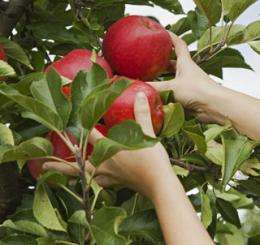Rising labor costs could trigger changes in produce industry

(PhysOrg.com) -- Immigration reform and stricter enforcement of current immigration laws could significantly boost labor costs for California’s $20 billion fresh fruit, nut and vegetable crops, according to agricultural economists at UC Davis and the U.S. Department of Agriculture.
This, in turn, would likely prompt the industry to adjust by increasing mechanization and introducing harvesting aids to boost laborers’ productivity, they predict. Imports may also rise.
“California’s produce industry depends on a constant influx of new, foreign-born laborers, and more than half of those are unauthorized laborers, primarily from Mexico,” says Phillip Martin, a professor of agricultural and resource economics and one of the nation’s leading authorities on agricultural labor.
“The cost of hiring these laborers will likely rise as the U.S. government ramps up enforcement of immigration laws by installing more physical barriers along the U.S.-Mexico border and requiring more audits of workers’ I-9 employment verification forms,” Martin says.
He notes that such audits often cause workers to quit their jobs rather than clear up discrepancies in their documents. As a result, some farm employers already are making plans to hire higher-paid, legal guest workers, who must be provided with government-approved housing.
He projects that immigration reform could result in legalization of currently unauthorized farmworkers, again encouraging farm employers to turn to the higher paid guest workers to tend and harvest their crops.
If labor costs do rise, Martin suggests that three major adjustments could occur: mechanization to reduce the need for hand labor, an increase in produce imports if rising costs make U.S. produce less competitive, and introduction of more harvesting aids to increase the efficiency of laborers.
For example, there could be wider use of mechanized harvesting for raisin-grapes, a shift to more imports in the asparagus industry, and the use of harvesting aids — such as in-field conveyor belts — to speed strawberry harvest.
Martin’s study, conducted with Linda Calvin of the U.S. Department of Agriculture’s Economic Research Service, was supported by USDA and the University of California Giannini Foundation of Agricultural Economics. The report, titled “Labor Trajectories in California’s Produce Industry,” appears in the current issue of the ARE Update at: agecon.ucdavis.edu/extension/update/ .
Provided by UC Davis
















